Honduras << hon DOO ruhs >> is a small Central American country known for the production of bananas. Honduras is a poor country. Its people have a low average income.
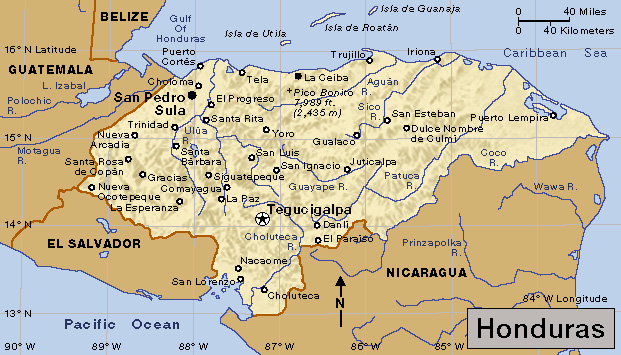
Bananas are one of Honduras’s leading sources of income. They are grown in the northern lowlands along the Caribbean Sea. In the inland mountains, many people raise beans, cattle, coffee, and corn. Tegucigalpa, the capital and largest city of Honduras, is located in this region. The country has limited transportation. Tegucigalpa is one of the few capitals in the world with no railroad. Hondurans raise cattle on the plains bordering the Pacific Ocean in the southern part of the country.
The Italian explorer Christopher Columbus arrived at Honduras in 1502. Columbus or a later explorer called the land Honduras, the Spanish word for depths, because of the deep waters off the northern coast of the country.
Government
The president is the head of the government of Honduras. The people elect the president to a four-year term. The president appoints a Cabinet to help carry out the day-to-day operations of the government.
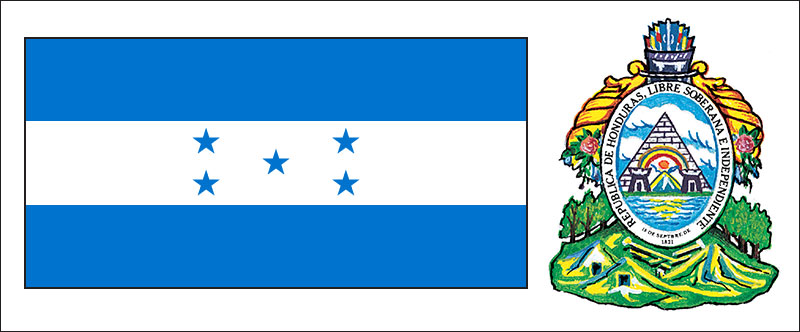
The National Congress is the country’s legislature. The 128 members of the congress are elected to four-year terms. The Supreme Court of Justice is the country’s highest court.
Through the years, the military has had much influence in the government of Honduras. For example, the country’s military leaders have often vetoed the president’s appointments to the Cabinet. Military leaders in Honduras have often taken complete control of the government. See the History section of this article for details of the military’s role in the Honduran government.
People
Most rural Hondurans are poor peasants who own or rent small farms. These people have poor transportation and communication. They often are cut off from the life of the cities.
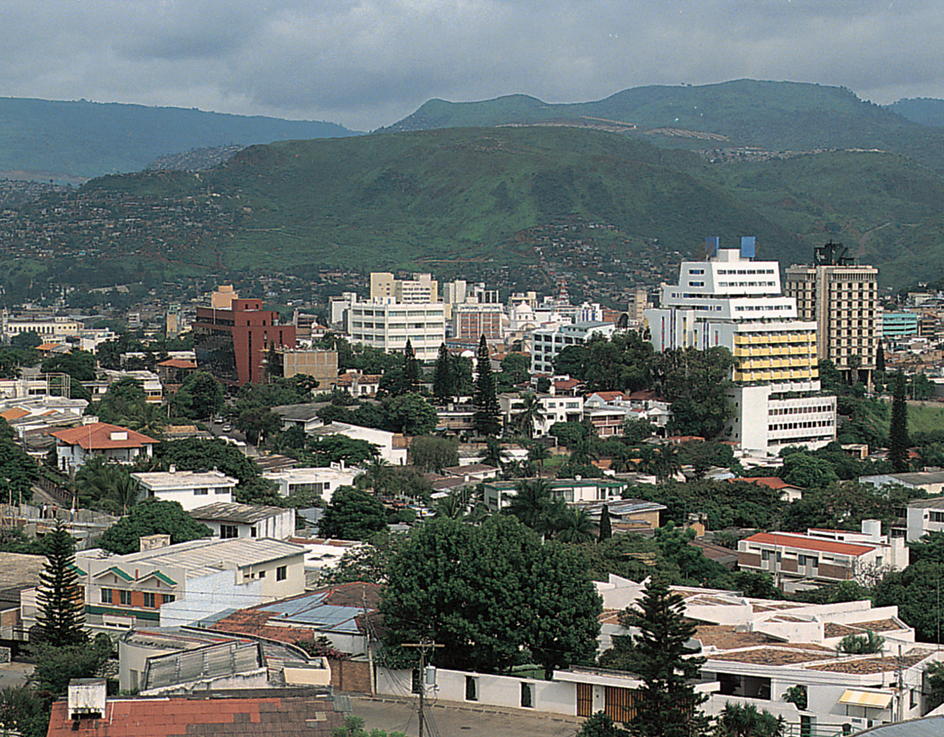
Modernizing changes are taking place in the cities because of expanding industry and education. However, such changes are only slowly reaching rural areas. Most rural Hondurans live in small houses made of adobe, boards, or poles, or of dirt and stones packed into a wooden frame.
Tegucigalpa, the capital, is also Honduras’s largest city. Other large cities include Choloma, La Ceiba, and San Pedro Sula.
Ancestry.
About 90 percent of all Hondurans are mestizos—that is, people with both white and Indigenous (native) ancestry. Almost all mestizos speak Spanish. In the northern banana-growing areas and port cities, many people speak English. They learned English because U.S. fruit companies have long done business there. A majority of Hondurans are Roman Catholics.
Tens of thousands of Indigenous Miskito people live in thinly populated northeastern Honduras. They speak the Miskito language. Many Miskito belong to the Moravian Church, a Protestant sect of Christians.
Garifuna, or Black Carib, dwell along the northwestern coast of Honduras. These people are descended from enslaved Black people and Indigenous Arawak people on the Caribbean island of St. Vincent. In 1797, the British rulers of St. Vincent deported people to Honduras because they rebelled. The Garifuna speak an Arawak language. Most also speak Spanish, English, or both. Hundreds of thousands of Garifuna live in Honduras.
The people of the Bay Islands, which lie off the northern coast, are mostly English-speaking Protestants. They include descendants of Garifuna, of English planters, and of formerly enslaved Black people who emigrated from the Cayman Islands in the Caribbean during the 1800’s.
Education.
Honduran law requires children to go to school from the age of 7 through 12. However, many children do not do so. Honduras does not have enough schools, especially in the rural areas. The country’s largest university is the National Autonomous University of Honduras. It was founded in Tegucigalpa in 1847. It has a branch campus in San Pedro Sula. The Zamorano Panamerican Agricultural School is a private university near the capital.
The land
Honduras has four main land regions: (1) the Mountainous Interior, (2) the Northern Coast, (3) the Northeastern Plain, and (4) the Southern Coast.
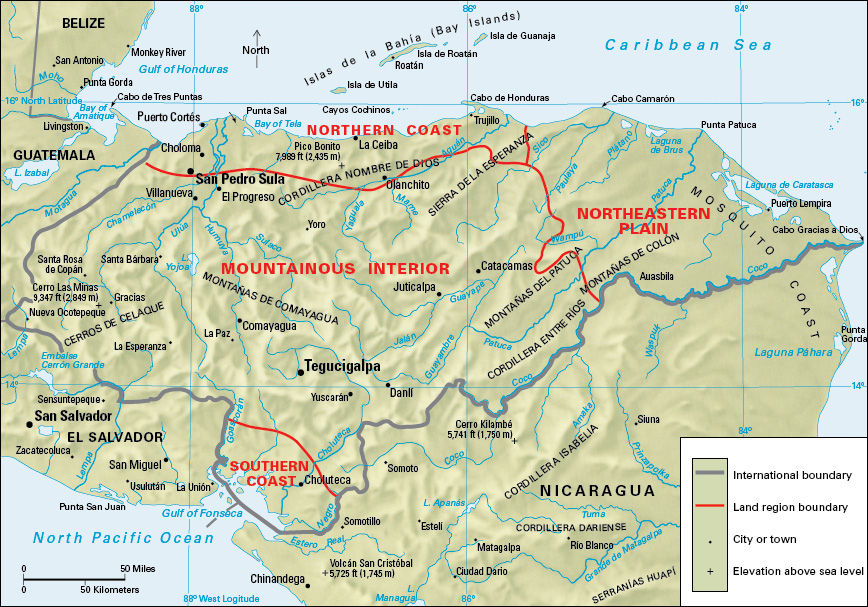
The Mountainous Interior
covers more than 60 percent of Honduras. The country’s highest point is 9,347 feet (2,849 meters) above sea level in the Cerros de Celaque, a mountain range. However, most Honduran mountains are much lower.
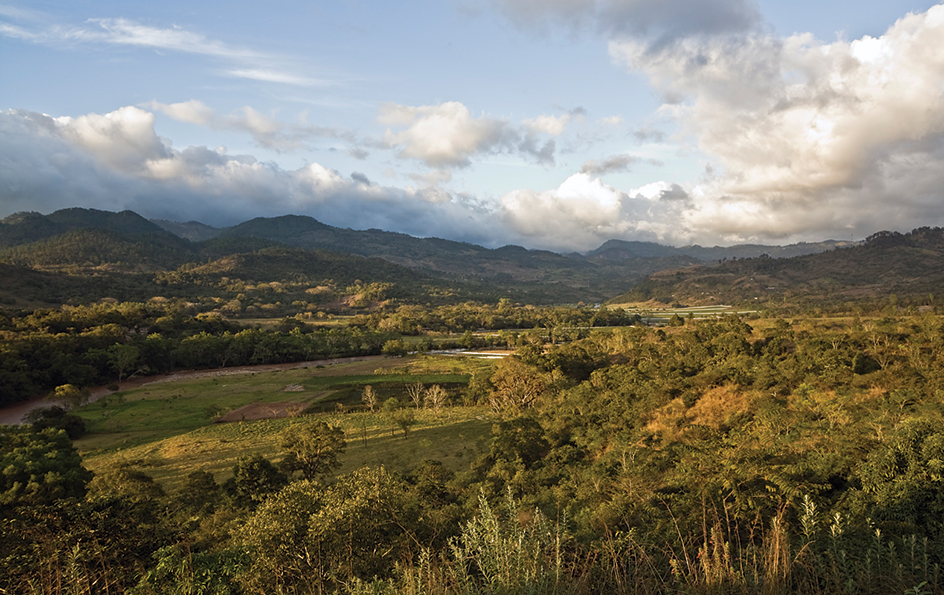
Forests of oaks and pines cover slopes below 7,000 feet (2,100 meters). Above the height of the oak and pine forests are forests of broadleaf evergreens. Where these cloud forests have been cut down, there are patches of scrub pines.
Honduras has no live volcanoes, though neighboring countries do. As a result, Honduras lacks soils made especially fertile by volcanic ash. But a number of small upland valleys in the Mountainous Interior have rich soils that support many farmers, particularly in the western and central parts of the region.
The Northern Coast
is the banana-producing region of Honduras. The most important banana areas are the fertile Ulua-Chamelecón River Basin and the coastal plain near the port of Tela. San Pedro Sula, the second largest city in Honduras, is the region’s major commercial center. Nearby Puerto Cortés is the country’s leading port.
The Northern Coast has the only railroads in Honduras. The railroads were built chiefly to carry bananas from plantations to the ports. They extend only about 65 miles (105 kilometers) inland.
East of La Ceiba, the region is largely undeveloped and sparsely populated. It consists of grasslands, swamps, and palm and pine forests. There is some farming in the Aguan Valley and other river valleys.
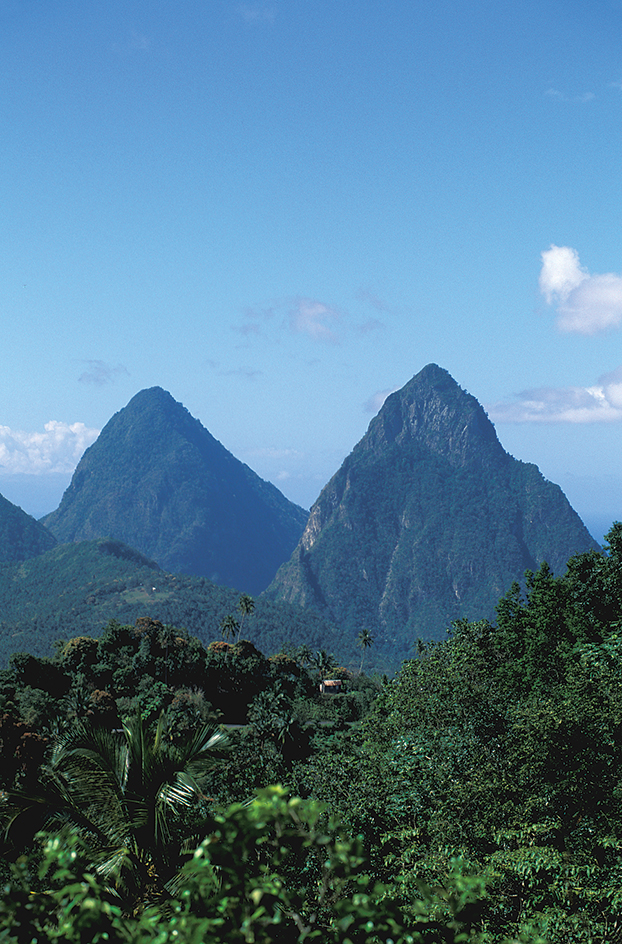
The Northeastern Plain
is the least developed and most thinly populated region of Honduras. It has some small Indigenous communities and a few little towns. Tropical rain forests cover much of the region. They make up a hot, wet area called the Mosquito Coast, or Mosquitia. The plain also has grasslands and some forests of pine and palm trees.
The country’s border with Nicaragua was disputed until 1960. The International Court of Justice in the Netherlands decided in favor of the Honduran claim, and the border was established at the Coco, or Wanks, River. Honduras also owns the Swan Islands, two small islands about 125 miles (201 kilometers) to the north in the Caribbean Sea.
The Southern Coast,
on the Gulf of Fonseca, is Honduras’s only outlet to the Pacific Ocean. Mangrove trees grow along the shoreline. Narrow plains lie beyond the shore. The largest plain is that of the Choluteca River in the Choluteca department (administrative district). It has rich soils that support many farms and cattle ranches. San Lorenzo is the chief port on the Southern Coast.
Climate
Honduras has a tropical climate that becomes cooler in the mountains with the increase of altitude. The coastal lowlands have an average yearly temperature of 88 °F (31 °C), with little seasonal change. Tegucigalpa is about 3,200 feet (975 meters) above sea level. The capital’s average daily high and low temperatures are about 85 and 65 °F (30 and 18 °C) in May, the warmest month. In December, the coolest month, they are about 76 and 60 °F (25 and 15 °C). The highland areas have mild temperatures.
The rainy season begins in May. It ends by November or December in the southern and central highlands, which receive a yearly average of 30 to 60 inches (76 to 152 centimeters) of rain. The rain falls until February in the north, and almost throughout the year in the northeast. That region of tropical rain forests, the wettest part of Honduras, has more than 100 inches (250 centimeters) of rain a year. Hurricanes sometimes hit the Northern Coast and damage crops.
Economy
Honduras has few resources. Its economy is one of the least developed in Latin America, and many of the country’s people live in poverty. Agriculture is one of the most important economic activities in Honduras. Much of the country’s income comes from banana and coffee exports. However, as the country’s economy becomes more diversified, agriculture is decreasing in importance. Remittances (money sent home) from Hondurans working abroad are another important source of national income.
Agriculture
employs more Honduran workers than any other economic activity. Bananas and coffee are among Honduras’s chief agricultural products and two of its chief exports. Farmers also grow beans, corn, oranges, plantains, sugar cane, and tomatoes. Honduras is an important producer of palm oil. Beef and dairy cattle are raised in the highland valleys and southern grasslands. Farmers also raise chickens for eggs and meat. Lobster and shrimp are the leading fishing catches.
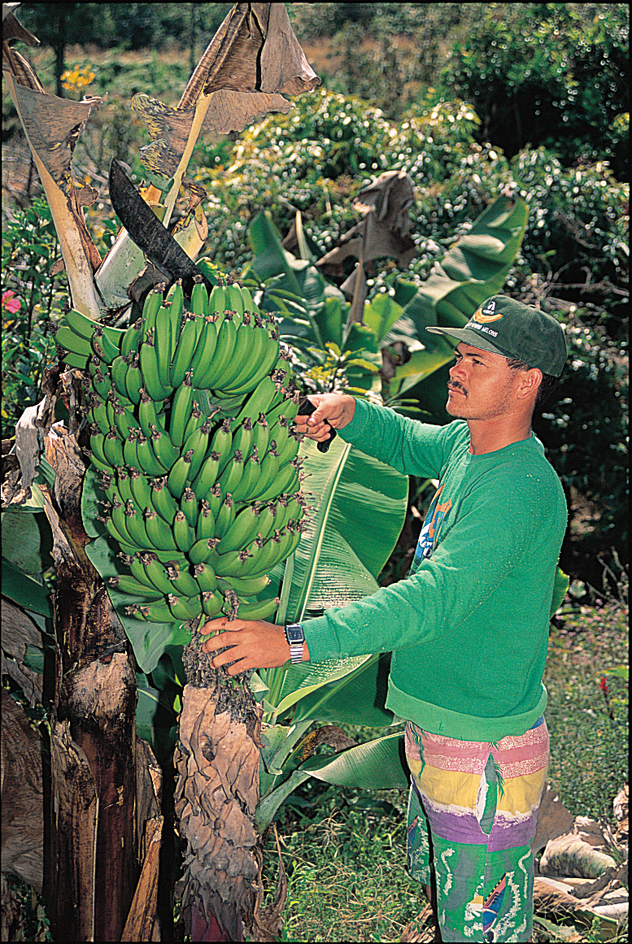
Service industries.
Community, government, and personal services form Honduras’s leading service industry in terms of the gross domestic product—that is, the value of goods and services produced within the country in a year. This industry includes various services, such as education and health care. Trade, restaurants, and hotels rank as the leading employer among the service industries. Much of the country’s trade industry is based on the distribution of agricultural products. Hotels and restaurants benefit from the hundreds of thousands of tourists who visit Honduras each year from the United States, Latin America, and other regions. The service industries are most important in the country’s largest cities, especially Tegucigalpa.
Manufacturing and mining.
The chief products made in Honduras include cement, cigarettes, clothing, processed foods and beverages, and textiles. Sawmills provide lumber for the furniture, paper, and wood products industries. Tegucigalpa and San Pedro Sula are major manufacturing centers. Pottery articles, used widely in Honduran households, are made in rural homes as a craft industry.
Mining contributes a small amount to Honduras’s economy. The country mines gold, lead, silver, and zinc. Honduras has no known oil reserves and must import all of its oil.
International trade.
Honduras imports more than it exports. The country imports chemicals, food products, machinery, motor vehicles, and petroleum products. Leading exports include bananas, coffee, gold, lobster, palm oil, paper products, and shrimp. The United States is Honduras’s leading trade partner. Honduras also does much trade with China, El Salvador, Guatemala, and Mexico.
Transportation.
Most Honduran roads, especially in rural areas, are unpaved. Honduran railways—operated mostly by the fruit companies—serve the Northern Coast region. La Ceiba, Puerto Cortés, San Lorenzo, and Tela have important seaports. San Pedro Sula and Tegucigalpa have major international airports.
Communication.
Honduras has a number of daily newspapers. The largest include El Heraldo and La Tribuna of Tegucigalpa and La Prensa of San Pedro Sula. Most of the radio and television stations are privately owned.
History
The Indigenous period.
Historians know little of what is now Honduras before the arrival of the Spaniards in the early 1500’s. An eastern center of the Maya civilization had thrived at Copán until the 800’s. Copán had beautiful stone palaces, pyramids, and temples. Its people were advanced in science and other learning. But by the time the Spaniards arrived, Copán lay in ruins, and the Indigenous people of the region had forgotten the city.
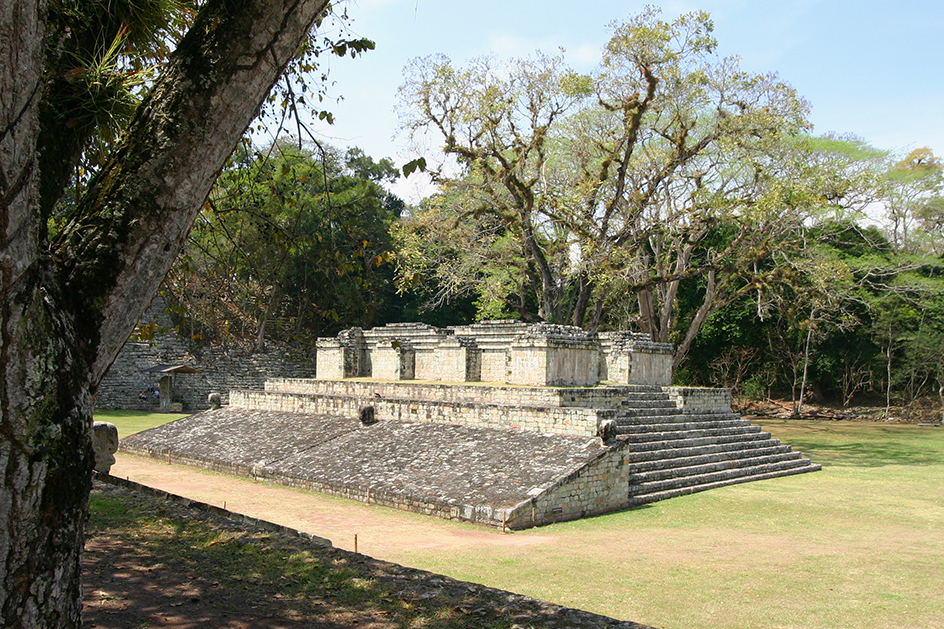
The colonial period.
In 1502, the Italian navigator Christopher Columbus landed at Cabo de Honduras (Cape Honduras). He claimed the land for Spain. A number of Spanish explorers soon visited the region and founded settlements. The Spaniards gradually conquered the Indigenous people. Many Indigenous people were killed, died of disease, or were enslaved and sent to plantations in the Caribbean.
The Spaniards developed gold and silver mines in Honduras. They brought many Black people from Africa and enslaved them to work in the mines along with the Indigenous people. The Spaniards also developed cattle ranches to supply food to the mining centers. But the mines were not profitable enough to attract many colonists.
Independence.
On Sept. 15, 1821, Honduras and four other Central American states declared their independence from Spain. They became part of the Mexican Empire. In 1823, they broke away from the empire and formed the United Provinces of Central America. This union generally followed liberal policies. It established some civil rights and ended the special privileges of the powerful nobility and the Roman Catholic Church. Honduras left the union in 1838. By then, the union had begun to fall apart under various pressures, including efforts by landowners and the clergy to regain their privileges.
Honduras was the weakest country in Central America. It soon came under the influence of its more powerful neighbors, especially Guatemala. During the 1800’s, Guatemala started or aided several revolts in Honduras. It supported Honduran conservatives or liberals, depending on which group was in power in Guatemala.
United States fruit companies began arriving in the 1890’s to grow bananas in Honduras. The companies cleared forests and drained swamps for plantations in the Northern Coast region. They also built railroads and ports. In addition, they established towns, hospitals, and schools for the workers.
In the early 1900’s, bananas became Honduras’s leading source of income. Export taxes paid by the U.S. fruit companies took care of most of the Honduran government’s expenses. The government gave the companies special privileges to increase this income, and the firms developed a strong influence over the government. The term banana republic, referring to a number of Latin American countries, was first used for Honduras.
Revolutions and reforms.
Until 1933, most Honduran presidents did not serve long because of frequent revolutions. General Tiburcio Carías Andino became president in 1933 and held office for 16 years, the longest period. Carías ruled as a dictator. Several revolts failed to overthrow him. He retired in 1948.
More political violence during the 1950’s led to the election of Ramón Villeda Morales, a physician, who became president in 1957. Villeda established a land reform program. He also built hospitals, roads, and schools.
In 1963, a military revolt led by Colonel Osvaldo López Arellano overthrew the government. An elected assembly wrote a new constitution that provided for López to become president. In 1971, the voters elected Ramon Ernesto Cruz, a lawyer, to the presidency. But in 1972, the armed forces overthrew the Cruz government and López again became president.
In 1969, a Honduran land reform law forced many families from El Salvador living in Honduras to give up their land. Salvadoran troops invaded Honduras in July 1969 but left in August. In 1970, the Organization of American States (OAS) helped the two nations set up a neutral zone along their border. In 1992, the countries ended their border dispute.
In 1975, the armed forces removed López from office. They replaced him with Colonel Juan Alberto Melgar Castro. López’s government had been involved in a scandal over a bribe from a U.S. firm to reduce the export tax on bananas. In 1978, three leaders of the armed forces removed Melgar from office and took over. In 1981, elections for a civilian government were held. The voters elected a civilian president and a legislature. Since 1981, Hondurans have elected a president and legislature every four years.
The late 1900’s.
During the 1980’s, Honduras became a site of clashes between troops of the Sandinista government of Nicaragua and Nicaraguan rebels trying to overthrow the Sandinistas. The rebels, called contras, set up bases in Honduras and raided Nicaragua from the bases. Sandinista troops sometimes entered Honduras to attack the contras. The conflict ended in 1990, after the Sandinista government of Nicaragua was voted out of office. See Nicaragua (The late 1900’s).
In 1998, Hurricane Mitch struck Honduras, producing floods and landslides throughout the country. The storm killed about 7,000 people, ruined half of the country’s crops, and washed away most major roads and bridges.
The early 2000’s.
Manuel Zelaya of the Liberal Party was elected president in 2005 and took office in 2006. In 2009, Zelaya tried to hold a referendum (public vote) on changes to the national Constitution. Critics claimed that the referendum was unconstitutional and that Zelaya was trying to eliminate presidential term limits. Military forces ousted Zelaya in June and forced him into exile. The president of Congress, Roberto Micheletti, became president of Honduras.
In November 2009, Porfirio Lobo Sosa of the conservative National Party won a presidential election organized by Micheletti’s government. However, some countries refused to recognize the election results because Micheletti’s government had taken power through a coup (sudden take-over). Lobo took office in 2010. In 2011, Lobo and Zelaya signed an accord allowing Zelaya to return from exile and reenter politics.
Juan Orlando Hernández of the National Party was elected president in 2013 and took office in 2014. In 2015, the Supreme Court eliminated limits on reelection. Hernández won a second term as president in 2017, amid accusations of fraud. Antigovernment demonstrations occurred after the election and in the following years, and a number of protesters were killed.
Xiomara Castro, the candidate of the left-wing Liberty and Refoundation Party and the wife of Manuel Zelaya, was elected president in 2021. She took office as Honduras’s first woman president in 2022.
